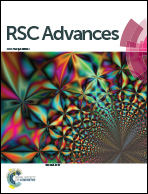Chemoselective reactions under solvent-free conditions: lanthanide-catalyzed syntheses of 2-amino-3,1-benzothiazines and 3,4-dihydroquinazoline-2-thiones†
Abstract
A catalyst-controlled chemoselective reaction of o-aminocinnamate and isothiocyanates in the presence of lanthanide complexes under mild and solvent-free conditions was developed. 2-Amino-3,1-benzothiazines were obtained in high yields when the reactions were catalyzed by Yb(OTf)3, whereas those catalyzed by [(Me3Si)2N]3La(μ-Cl)Li(THF)3 afforded 3,4-dihydroquinazoline-2-thiones in high to excellent yields. The mechanism for the product selectivity and high efficiency of the reaction was proposed.


 Please wait while we load your content...
Please wait while we load your content...